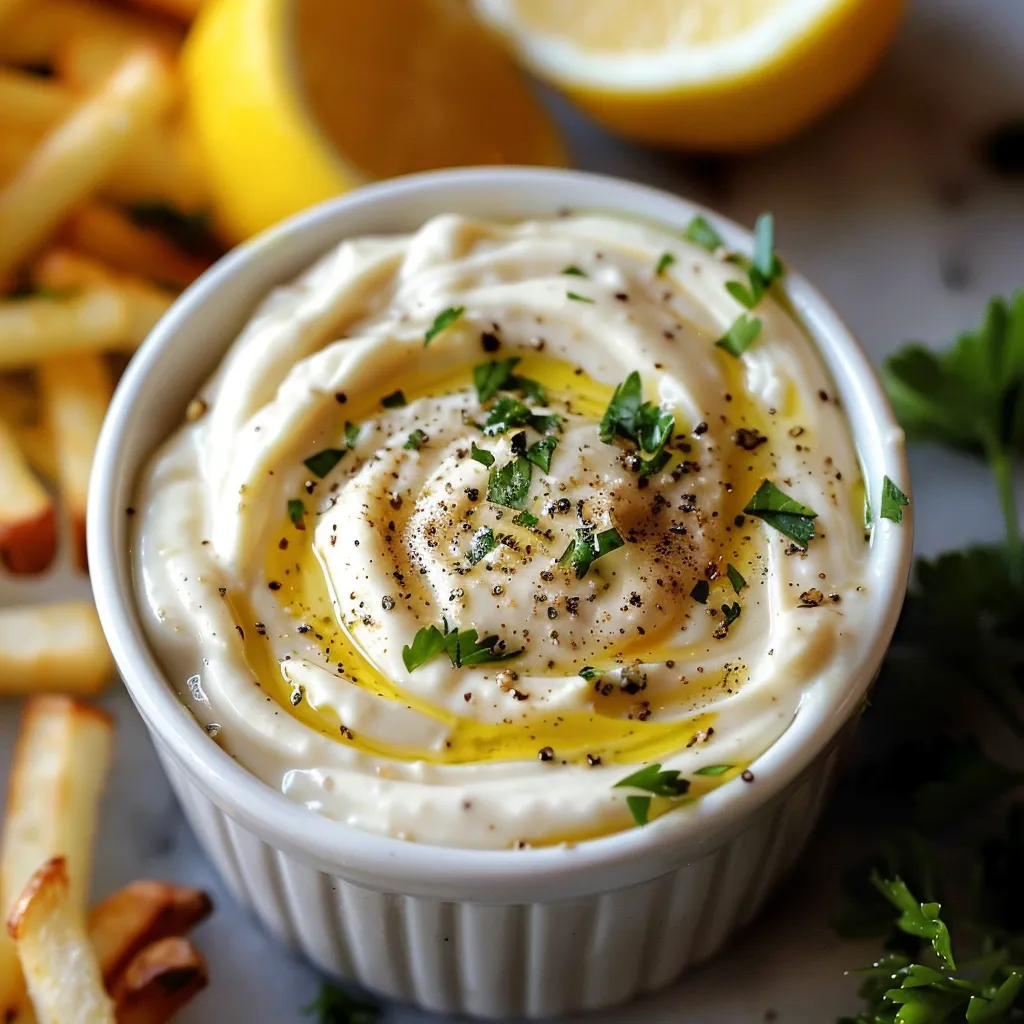 Pin it
Pin it
This classic garlic aioli elevates any dish with its rich, creamy texture and deep garlic flavor. Whether choosing the traditional emulsified version or quick adaptation, proper technique creates a sauce that's both sophisticated and versatile.
Foundations of Great Flavor
- Fresh Garlic Cloves: Firm and smooth with tight skin, these cloves bring a bold, slightly sweet depth to any dish when crushed or minced.
- Premium Olive Oil: Smooth and fruity with a hint of pepperiness, never bitter. It adds richness and enhances flavors in dressings and sauces.
- Neutral Vegetable Oil: A clean, mild oil with a high smoke point, perfect for cooking without overpowering other ingredients.
- Fresh Lemons: Juicy and bright, with thin skin and a strong citrus aroma. Fresh-squeezed juice and zest add a natural zing that bottled versions can’t match.
- High-Quality Kosher Salt: Light and flaky, it dissolves easily and brings out the best in every ingredient without being too harsh.
- Fresh Large Eggs: Left at room temperature for better mixing, they create a smooth texture and help ingredients come together effortlessly.
- Premium Dijon Mustard: Creamy with a slight tang, it’s the secret to a perfectly emulsified sauce or dressing.
- Quality Mayonnaise: A rich, ready-made option that keeps things simple while still delivering a silky texture.
- Black Pepper: Freshly ground for a warm, slightly sharp kick that balances flavors beautifully.
- Optional Fresh Herbs: A touch of parsley, chives, or basil adds color and freshness, making every bite more vibrant.
Culinary Choreography
- Garlic Preparation:
- Smash garlic cloves to release essential oils. Mince finely, then combine with salt to create smooth paste. Allow flavors to develop through brief resting period.
- Emulsion Creation (Classic):
- Begin with room temperature ingredients. Create stable base with eggs and lemon. Add oils in extremely thin stream while whisking constantly. Watch for proper thickening and emulsification.
- Quick Method Assembly:
- Combine garlic paste with mayonnaise base. Add seasonings gradually, tasting frequently. Adjust consistency with lemon juice as needed.
- Final Seasoning:
- Taste and adjust both versions carefully. Consider balance of garlic, acid, and salt. Allow flavors to meld briefly before final adjustments.
 Pin it
Pin it
My French chef mentor taught me to add a tiny pinch of white pepper it adds depth without changing the sauce's appearance.
Storage Solutions
Store both versions in airtight glass containers in refrigerator. Classic version keeps for 3-4 days, while quick version lasts up to a week. Never freeze either version as this destroys emulsion. Before serving, allow to come to room temperature for 15-20 minutes and whisk briefly if any separation has occurred.
Perfect Pairings
Transform dishes with thoughtful aioli applications. Serve alongside crispy french fries or roasted potatoes. Spread on artisan sandwiches or burgers. Create elegant dipping sauce for seafood or grilled vegetables. Consider as base for potato salad or coleslaw dressing.
Creative Variations
Adapt these base recipes while maintaining proper technique. Create herb version with fresh basil and parsley. Develop smoky variation using roasted garlic. Some chefs add crushed saffron threads, while others incorporate sundried tomatoes. Consider adding fresh herbs like tarragon or dill for specific pairings.
 Pin it
Pin it
Serving Suggestions
Present aioli in small ramekins for dipping. Drizzle artistically over plated dishes. Create swirls or dots for elegant presentation. Consider garnishing with fresh herbs, lemon zest, or cracked pepper. When serving as sandwich spread, apply generously but evenly.
This garlic aioli represents the perfect balance of traditional technique and modern convenience. The combination of proper preparation and quality ingredients creates a versatile sauce that elevates any dish. Whether using the classic or quick method, this recipe consistently delivers professional results that enhance both casual and elegant meals.
Frequently Asked Questions
- → Why do I need to emulsify the oil slowly?
- Adding oil gradually while whisking ensures proper emulsification, preventing the sauce from separating and creating a smooth, creamy texture.
- → Can I use all olive oil?
- While possible, using half lighter oil helps prevent an overly strong olive oil taste that might overpower other flavors.
- → How long does aioli last?
- Homemade aioli can be stored in the refrigerator for up to 4 days in an airtight container.
- → Is raw egg safe in aioli?
- While traditional aioli uses raw egg, use fresh, properly refrigerated eggs. Those concerned can opt for the quick version with mayonnaise.
- → Why let the garlic mixture sit for 15 minutes?
- This resting time allows the garlic to infuse the lemon juice, developing deeper flavor throughout the sauce.
